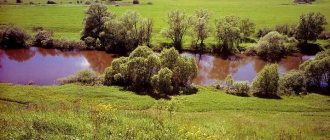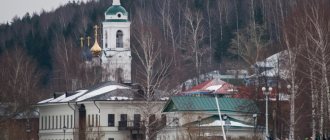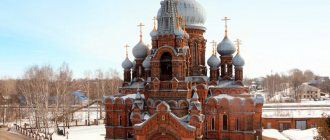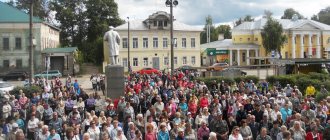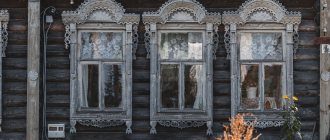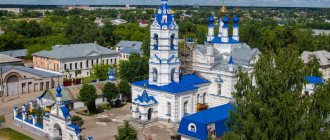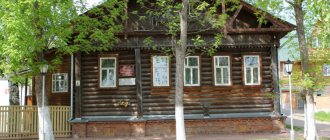General information about the Ivanovo region
One of the smallest regions, located in the central part of Russia.
Representatives of the flora and fauna of the Ivanovo region are listed in the Red Book. The region is replete with expanses of water and numerous forested areas. Located in the central part of Russia. It occupies 21.4 thousand kilometers. It borders with four regions: Kostroma, Yaroslavl, Nizhny Novgorod and Vladimir. The length does not exceed 160 kilometers, and the width is only 230 kilometers. The central part of the region is most densely populated. Industry is concentrated here and large cities are built. This is also where the bulk of agricultural land is located.
History[edit]
Church of St. Barbara, Plyos
The Ivanovo region at the beginning of its history was a melting pot between different peoples, such as Russians, Europeans, Asians and others. Various ancient Ural and ancient Slavic tribes inhabited here. [13]
Ivanovo industrial region (Ivanovo industrial region) was formed on October 1, 1929. [14] On March 11, 1936, part of it became the modern Ivanovo region, and the remaining part was allocated to the Yaroslavl region. [4] On May 21, 1998, the Ivanovo region, together with the Amur, Kostroma, Voronezh regions and the Republic of Mari El, signed a power-sharing agreement with the federal government, granting it autonomy. [15] This agreement will be canceled on February 26, 2002. [16]
Relief of the Ivanovo region
Occupies lands located in the central part of the East European Plain. The landscape is represented by plains with small hills, gradually turning into lowlands. There are no hills or mountains. There are many reservoirs on the territory of the Ivanovo region. These are mostly small lakes, some of which are swampy. The coastline is unclear during spring floods and is connected into a single surface of water with numerous tributaries and lakes.
Map of Ivanovo region with cities and villages
Moving around the map of the Ivanovo region with cities and villages, you can not only see the location of settlements, but also see their streets, houses and attractions. The most famous cities in the region through which the Golden Ring tourist route passes are Ivanovo, Plekh and Ples. But the most attractive is the city of Yuryevets and its main attractions:
- A. Tarkovsky Museum;
- five-tier bell tower;
- Mount Asaph.
The location of the city on the banks of a beautiful reservoir attracts not only lovers of historical monuments and connoisseurs of ancient Russian crafts, but also numerous fishermen who come here in whole companies.
Using a map of the Ivanovo region with villages, you can find another amazing settlement - the village of Kholui. Before the revolution, it was the center of icon painting in Russia. Icons painted in this village are exhibited in the most famous churches in the country. Currently, souvenir lacquer miniatures are made here, which tourists are happy to purchase.
Minerals of the Ivanovo region
The Ivanovo region is not replete with mineral deposits. The origin of the existing ones is sedimentary. There are studied deposits of phosphorites, a couple of developments of glass sands, building materials: clay, sand. The region has organized the production of building materials using its own raw materials. Underground reserves of fresh water and mineral springs have been discovered. There are reservoirs with medicinal table water.
Peat and sapropel are being developed and extracted.
Oil and gas of the Ivanovo region
Oil and gas deposits in the region were discovered in the 70s of the last century. But they were recognized as insignificant and unpromising, especially after the discovery of the Tyumen deposits.
Politics[edit]
During the Soviet period, high authority in the region was divided between three persons: the first secretary of the Ivanovo Committee of the CPSU (who actually had the greatest powers), the chairman of the regional council (legislative power) and the chairman of the regional council. regional executive committee (executive branch). Since 1991, the CPSU lost all power when the head of the regional administration, and later the governor, were appointed/elected along with the elected regional parliament.
The Charter of the Ivanovo Region is the basic law of the region. The Legislative Assembly of the Ivanovo Region is a permanent legislative (representative) body of the region. The Legislative Assembly exercises its powers by adopting laws, regulations and other legal acts, as well as monitoring the implementation and compliance with the laws and other legal acts adopted by it. The highest executive body is the Regional Government, which includes territorial executive bodies such as district administrations, committees and commissions that promote development and manage the day-to-day affairs of the region. The regional administration supports the activities of the Governor, who is the highest official and acts as a guarantor of compliance with the regional charter in accordance with the Constitution of Russia.
Climate of the Ivanovo region
The climate is characterized as moderate continental: without sharp temperature fluctuations. At the same time, cyclones and weather changes are frequent. The climate is influenced by air masses originating in the Atlantic. Winters are quite mild with slight temperature fluctuations. Summer is also not very hot, but it is uniformly warm. The coldest month is January, with an average monthly temperature of about -12 degrees. The warmest month is July, but there are no significant temperature changes. The monthly average is about +17 degrees. The thickness of the snow cover can reach 50 centimeters; soil freezing occurs to a depth of 45 centimeters. Annual precipitation rarely exceeds 600 millimeters. Spring and autumn with moderate precipitation and a uniform decrease and increase in temperature. Melting snow and ice significantly increases water levels in reservoirs.
Ivanovo
Video: Ivanovo
Basic moments
The first mention of Ivanovo dates back to the 16th century. The founding date of Ivanovo is 1871 - it was in this year that the village of Ivanovo and Voznesensky Posad united. Unfortunately, the city has practically no surviving buildings dating back to the 16th century, but you should come to Ivanovo to admire the architecture of the late 19th-20th centuries. In particular, buildings dating back to the era of constructivism of the 20-30s are interesting. XX century, as well as mansions built in the Art Nouveau style.
Ivanovo today is part of the Golden Ring of Russia. From a tourist point of view, the city of Ivanovo is interesting for its attractions, such as the Shudrovskaya tent, the house-ship built in 1930, and the horseshoe house built in 1934. Interestingly, there is a circus in Ivanovo, a visit to which can also become one of the memorable events in Ivanovo.
There are approximately 27 hotels of various categories in Ivanovo, almost all of them are concentrated in the city center. Tourists in Ivanovo also have excellent restaurants and bars in the city.
Climate
The climate of Ivanovo belongs to the temperate continental type. As a rule, the coolest weather in Ivanovo occurs in January, at which time the air temperature in Ivanovo drops to -12 °C. It is warmest in Ivanovo in July, at which time the air warms up to +18.7 °C.
Attractions
Sights of Ivanovo include various architectural monuments, museums and other interesting objects.
In particular, such sights of Ivanovo as the Shchudrovskaya Tent - the oldest brick building in the city, the Ship House, designed by architect Friedman, and the buildings of the Ivanovo-Voznesensk Polytechnic Institute are interesting.
The religious attractions of Ivanovo include the Holy Vvedensky Convent, the Transfiguration Cathedral, the Church of the Holy Apostle, etc.
Also interesting are such sights of Ivanovo as the Burylinskaya library, which houses a rare and rich collection of all kinds of books, the house-museum of the artist Morozov, as well as the house-museum of the Bubnov family with a beautiful mezzanine.
We also recommend that tourists visit the Burylin Museum of Industry and Art.
Excursions
First of all, we recommend that tourists go on a sightseeing tour of Ivanovo, during which you can see the main attractions of Ivanovo - the Shchudrovsky tent, the Holy Vvedensky Monastery, the Duringer estate, etc.
Also interesting is an excursion from Ivanovo to Palekh and Shuya, during which you can touch the magical world of Russian art.
Story
The first mention of Ivanovo dates back to 1561: according to legend, Ivan the Terrible granted the village of Ivanovo and its adjacent villages to the Temryukovich-Cherkassky princes. At the beginning of the 17th century, Ivanovo was devastated by Polish-Lithuanian invaders. After this, it is reborn as a large commercial and industrial village.
In the 17th century, textile manufactories appeared here, and the village became the center of the linen industry.
In the first half of the 18th century, Ivanovo became a large fishing and trading village.
In 1705, by decree of Peter I, a customs hut was established here to collect various duties on trade to the treasury.
In the 18th century, cotton and calico printing production emerged in Ivanovo. The oldest civil stone building in Ivanovo dates back to the same century, which originally served as a hut and then came into the possession of the merchant Osip Shchudrov.
Since the end of the 18th century, on the southeastern outskirts of the village there was the Assumption Cemetery, where in 1815 a wooden church was moved from the former Intercession Monastery. In 1834, a new stone Assumption Cemetery Church with chapels of the Nativity of John the Baptist and Barbara the Great Martyr was built. Some of the icons were transferred from the wooden church.
In 1901, the Vvedenskaya Church was founded, which 90 years later became the Holy Vvedensky Convent.
Accommodation
Ivanovo hotels are presented on this page in the form of an objective rating based on reviews from tourists. So where to stay while on vacation in Ivanovo? You can easily find the answer here: all Ivanovo hotels are located below under the resort map in a table format convenient for tourists, which can be sorted by hotel name, by their star rating, by popularity (number of reviews), as well as by the average rating of tourists. in the reviews they leave. The description of each Ivanovo hotel contains its photographs in large format, a list of services available to hotel guests, hotel contact information, a map of Ivanovo with the hotel location, as well as detailed reviews from tourists.
Sports and active recreation
Active recreation in Ivanovo includes cycling, walking around the city, and bowling, for example, at the Volga club.
Also in Ivanovo, the Olympia entertainment and ice complex has been operating since 2008, and the Lokomotiv, Tekstilshchik, Burevestnik and Spartak stadiums have been opened.
Let us add that in Ivanovo there is a football team “Textilshchik” and a women’s basketball team “Energia”.
Transport
Public transport in Ivanovo includes trolleybuses, buses and minibuses, as well as just a taxi, which can be called from any hotel in Ivanovo.
Note that the trolleybus appeared in Ivanovo in 1962, the tram existed in Ivanovo from 1934 to 2008.
Souvenirs
Souvenirs from Ivanovo are, first of all, various woven products - pillows, aprons, tablecloths, napkins, etc. Secondly, don’t forget about traditional refrigerator magnets and cups, saucers and plates with views of Ivanovo. Also interesting are such souvenirs from Ivanovo as brightly decorated nesting dolls, whistles and other products of Ivanovo craftsmen.
Interesting Facts
- Ivanovo is called the “city of brides”, “calico land” and “Russian Manchester”.
- In 1579, the owners of the village built the Intercession Monastery near it. The peasants of the village of Ivanovo were engaged in arable farming, crafts, and trade.
- In 1742, peasant Grigory Butrimov founded the first manufactory in the village.
- In 1815, by decree of the Vladimir Spiritual Consistory, the Trinity Church with the chapel of Barbara the Great Martyr was moved to the Assumption Cemetery and consecrated in 1817 in honor of the Dormition of the Mother of God. Over time, the wooden church fell into disrepair. In 1849, the chapel of Barbara the Great Martyr was broken, and in 1883, services ceased. In 1904, the manufacturer and founder of the city museum D. Burylin moved the temple from the old Assumption Cemetery to the new Posad Cemetery. In 1906, the restored church was opened. In 1946, it was handed over to the Old Believers community and consecrated in honor of the icon of the Kazan Mother of God.
How to get there
There are several ways to get to Ivanovo from Moscow:
- By bus. Buses from Moscow to Ivanovo start from Shchelkovsky station, travel time is just over 5 hours.
- By train. Travel time on the Moscow-Kineshma train is just over 7 hours.
- By plane. Flights are carried out by air, travel time is 1 hour.
- By car. The distance between Moscow and Ivanovo is 297 km, travel time will be approximately 4.5 hours.
Inland waters of the Ivanovo region
The waterways of the Ivanovo region number 50 rivers exceeding 25 kilometers and many small rivers that feed them. The largest river in the region is the Volga. The number of streams and small tributaries exceeds 1,700. Spring floods cause severe overflow, flooding of floodplains and lowlands. All rivers belong to the Klyazma River basin. The largest rivers are Uvod, Teza, Nerl, Lukh. The largest reservoir is located on the Volga - Gorkovskoye.
The territory of the Ivanovo region is replete with small lakes and swamps. The latter accounts for 1.4 thousand square kilometers. There are a little more than 150 lakes, most of them are located in the south and central part of the region. Not all lakes are of natural origin. Some of them are formed as a result of the extraction of peat and sand. The peat bogs formed by the extraction of raw materials account for more than 45 thousand hectares.
Take away
The river on which the administrative center is located - the city of Ivanovo. The length of the river is 185 kilometers. It flows through the Ivanovo and Vladimir regions. The river is not navigable, rather shallow. Previously used for industrial purposes. Upstream there is a large reservoir - Uvodskoye. Downstream it flows into the Klyazma.
"City of Brides" and "Russian Manchester"
This is what Ivanovo-Voznesensk was called (this was the name the city of Ivanovo had until 1932) in the Russian Empire. Flax and hemp grow well on the loamy soils of the Ivanovo region. Thanks to the availability of raw materials, Ivanovo-Voznesensk became the largest textile center in Russia, maintaining its status both in the USSR and in post-Soviet times. The glory of the “city of brides” that has developed behind this beautiful Central Russian city is also understandable. The demand for the seamstress profession in Ivanovo is stable, so girls from all over the country went to the city on Uvodi to work as weavers and dressmakers. But it cannot be said that the gender balance in Ivanovo is heavily skewed towards the fair sex. Rather, the “city of brides” is a brand of the 37th region.
In the Russian Empire, Ivanovo-Voznesensk was not a provincial city, and not even a district one - it belonged to the Shuisky district of the Vladimir province and was the largest provincial city in the Empire. Now Shuya is the regional center of the Ivanovo region. The Ivanovo region itself was created in several stages - through the creation of the Ivanovo industrial region and its division. Now the Ivanovo region includes areas of the former Vladimir and Kostroma provinces. The final boundaries of the Ivanovo region were formed in 1994, when the Sokolsky district, separated from the rest of the region by the Gorky Reservoir, became part of the Nizhny Novgorod region. For more than 10 years, in order to call from Nizhny Novgorod to Sokolskoye, you had to dial the Ivanovo intercity code, and the registration plate of region 37 in Sokolskoye is not so rare. The transport infrastructure of the Ivanovo region has great prospects for development. Its main hubs are Ivanovo and Kineshma. The kilometer of highways in region 37 is 5,244 km, of which 5,017 km are paved. Despite the fact that the Ivanovo region is located quite advantageously for transit - it borders the Nizhny Novgorod, Vladimir, Kostroma and Yaroslavl regions, “region 37” is not yet using its potential sufficiently. However, thanks to the commissioning of the bridge across the Volga in Kineshma, the Ivanovo region has great prospects as a transit region between Siberia and the Far East, the Middle and Lower Volga region, on the one hand, and the North and North-West of Russia, on the other.
Map — Ivanovo region
Forests of Ivanovo region
In the Ivanovo region there is a mixture of vegetation characteristic of the taiga zone and mixed forests. Forest vegetation occupies almost half of the entire territory of the region. The northern and northeastern regions are represented by coniferous flora: spruce, pine. There are artificial plantings of Sukachev larch. Gradually, in the southern direction, deciduous forests begin to predominate, forming groves and copses. The transition between zones is smooth. Birch, linden, alder, aspen are the most common trees. There are small oak groves. The undergrowth and copses are filled with mountain ash, hazel and buckthorn bushes. Part of the territory occupied by swamps and river lands is occupied by shrubs and alder. The territory occupied by meadows is no more than 10%.
The lower tier of forests is formed by wild berries: lingonberries, blueberries, cloudberries, blueberries, many mushrooms, wild rosemary. Cranberries grow in the swamps.
Fauna of the Ivanovo region
There are over fifty representatives of mammals on the territory of the Ivanovo region. Some of them are listed in the country's Red Book. The Russian muskrat and the giant bat are the most prominent representatives.
The Ivanovo region abounds in hares, martens, squirrels, foxes and moose. Hunting is allowed. Minks are found in the wild. Predators include bears and wolves. There are several species of deer in the forests. There are badgers, beavers, roe deer, muskrats and raccoon dogs. Hunting is allowed for more than 70 species of animals.
There are many small rodents in the meadows and undergrowth, including shrews and moles.
Brown bears, muskrats, and lynx are included in the Red Book.
Birds of the Ivanovo region
A large number of forests are a favorable place for nesting of all kinds of birds. There are more than two hundred species of birds that have chosen the Ivanovo region for breeding chicks. 22 of which are listed in the Red Book. These are osprey, white-tailed eagle, golden eagle, peregrine falcon, steppe eagle and many others.
The most common inhabitants among birds are wood grouse, owls, thrushes, woodpeckers, numerous passerines, jackdaws, crows, and tits. More than 25 species of birds are not permanent residents of the region - they migrate, stopping here only for nesting.
Birds of the Ivanovo region are divided into:
- sedentary, permanent residents (tits, jackdaws, hooded crows, pigeons),
- migratory or insectivorous (swallows, orioles, cuckoos, swifts),
- nomadic (bullfinches, waxwings, long-eared owls),
- wintering, arriving only in winter (brown buzzard, snow bunting),
- migratory birds (geese, ducks, waders),
- vagrants, once noted by ornithologists within the region (steppe eagle, little auk, cormorant).
River inhabitants of the Ivanovo region
The presence of a network of waterways and numerous lakes is a favorable place for waterfowl. There are a lot of ducks, geese, river muskrats, and beavers. Duck hunting opens in the spring, and geese hunting in the fall. The most common fish in reservoirs are pike, sabrefish, roach, crucian carp, tench and bream. The rivers are inhabited by sturgeon and beluga. In total, more than 45 species of different fish have been recorded.
The otter, European grayling, and river trout are listed in the Red Book.
There are few species of amphibians and reptiles, but they live in large numbers. The grass frog is the most famous representative, which is found almost everywhere.
Protected areas of the Ivanovo region
In total, there are more than 700 areas in the Ivanovo region that have protected status. They are allowed to visit for the purpose of recreation and tourism. These objects include lakes, more than thirty swamps, forests, parks, reservoirs, single trees and many other attractions. There are five nature reserves in the Ivanovo region, the largest being Mirslavsky. One of the reserves, Klyazmensky, has federal status.
Klyazmensky reserve
A protected natural area, which is part of the Meshchera protected park. It occupies an area of 21 thousand hectares. The lands included in the reserve are located in two regions: Ivanovo and Vladimir. Founded in 1978. Formed by the floodplains of three rivers. The territory consists of many lakes, marshy areas, and unique vegetation, a bit reminiscent of Karelian landscapes. The predominant vegetation is pine, birch, oak, and maple. Lots of lingonberries, blueberries, heather. Swampy soils abound with mosses.
A diverse fauna, mainly with a halo of habitat near water bodies: muskrat, beaver, marten, several species of ducks. Black grouse, wood grouse, and hazel grouse live here. There is a unique bird, the white-tailed eagle. More than twenty species of animals live here.
Zavolzhsky reserve
The forest area predominates, which serves as a habitat for moose, hares, foxes, and wild boars. Lynxes and wolves and brown bears are also found here, but not often. This is a favorable habitat for black grouse, wood grouse, and hazel grouse.
Uvodskoye Reservoir
One of the largest reservoirs supplying the region with water is located on the Uvod River in the Ivanovo district. It represents a natural complex in which more than 14 species of fish coexist: pike, roach, ide, saberfish, mustard, roach, crucian carp and many others. The coastline is not very indented and is framed by mixed forests. Part of the coast abuts meadow areas, which are flooded when there is a flood.
Gorky Reservoir
Formed by a hydroelectric dam on the Volga River. It has another name - the Gorky Sea (Grief-Sea). This is due to bizarre weather changes and the sudden appearance of two-meter waves. The right side of the reservoir is navigable, although the average depth is slightly more than 3.6 meters. Connects four regions: Ivanovo, Kostroma, Nizhny Novgorod and Yaroslavl.
A real paradise for fishermen: bream, carp, pike, crucian carp are found here. There are many recreation centers on the coast.
Links[edit]
Notes[edit]
- President of Russian Federation. Decree No. 849 of May 13, 2000 “On the Plenipotentiary Representative of the President of the Russian Federation in the Federal District.” Entered into force on May 13, 2000. Published: “Collection of Legislation of the Russian Federation”, No. 20, Art. 2112, May 15, 2000 (Decree of the President of the Russian Federation of May 13, 2000 No. 849 “ On the Plenipotentiary Representative of the President of the Russian Federation in the Federal District
.” Entered into force on May 13, 2000). - Gosstandart of the Russian Federation. No. OK 024-95 December 27, 1995 “All-Russian classifier of economic regions. 2. Economic regions,” ed. Changes No. 5 / 2001 OKER. (Gosstandart of the Russian Federation. No. OK 024-95 dated December 27, 1995. Russian classification of economic regions. 2. Economic regions
as amended by Amendment No. 5/2001 OKER.). - Article 5 of the Charter of the Ivanovo Region states that the symbols of the region include the flag and coat of arms, but not the anthem.
- ^ ab Ivanovo region.
Administrative-territorial structure , page 26 - Charter of the Ivanovo region, article 7
- ^ab Charter, Article 9
- Official website of the Ivanovo region. Pavel Alekseevich Konkov, governor of the Ivanovo region (in Russian)
- Federal State Statistics Service (Federal State Statistics Service) (May 21, 2004). "Territory, number, settlements and administrations by subject of the Russian Federation (territory, number of districts, settlements and rural administration by subject of the Russian Federation)". All-Russian Population Census of 2002 (All-Russian Population Census of 2002
). Federal State Statistics Service. Retrieved November 1, 2011. - ^ abcd Federal State Statistics Service (2011). All-Russian Population Census 2010. Volume 1 [All-Russian Population Census 2010, vol. 1]. All-Russian Population Census 2010 [All-Russian Population Census 2010] (in Russian). Federal State Statistics Service.
- "26. The size of the permanent population of the Russian Federation by municipalities as of January 1, 2021". Federal State Statistics Service. Retrieved January 23, 2021.
- "On the Calculation of Time". Official Internet portal of legal information
. June 3, 2011. Retrieved January 19, 2021. - An official throughout the Russian Federation in accordance with Article 68.1 of the Russian Constitution.
- "Mitochondrial DNA polymorphism in the Russian population from five regions of the European part of Russia".
- Ivanovo region.
Administrative-territorial structure , page 22 - “News feed - May 22, 1998. Yeltsin signs new power-sharing agreements with the regions.” Radio Free Europe/Radio Liberty
. Retrieved May 2, 2021. - Chuman Mizuki. "The Rise and Fall of Center-Regional Power-Sharing Treaties in Post-Soviet Russia" (PDF). Democratization
: 146. - ↑
Federal State Statistics Service of Russia (May 21, 2004). The population of the Russian Federation as part of federal districts, urban settlements, settlements, settlements, settlements, settlements, settlements, settlements, settlements, settlements, settlements settlements, settlements, settlements, settlements.[Population of Russia, its federal districts, constituent entities of the Federation, districts, urban settlements, rural settlements - administrative centers and rural settlements with a population of more than 3000 people] (XLS). All-Russian Population Census of 2002 [All-Russian Population Census of 2002] (in Russian). - All-Union Population Census of 1989 Population of Union and Autonomous Republics, Autonomous Regions and Districts, Territories, Regions, Urban Settlements and Village District Centers [All-Union Population Census of 1989: Current Population of Union and Autonomous Republics, Autonomous Regions and Districts, Territories, Regions , districts, urban settlements and villages performing the functions of district administrative centers]. All-Union Population Census of 1989 [All-Union Population Census of 1989] (in Russian). Institute of Demography of the National Research University: Higher School of Economics [Institute of Demography of the National Research University: Higher School of Economics]. 1989 - via Demoscope Weekly
. - "Natural movement of the population in the context of the constituent entities of the Russian Federation". www.gks.ru.
_ - https://www.gks.ru/wps/wcm/connect/rosstat_main/rosstat/ru/statistics/publications/catalog/doc_1137674209312
- https://www.perepis-2010.ru/news/detail.php?ID=6936
- ^ abc "Arena: Atlas of religions and nationalities of Russia". Wednesday, 2012.
- 2012 Arena Atlas Religious Maps. “Ogonyok”, No. 34 (5243), 08/27/2012. Retrieved 04/21/2017. Archived.
Sources [edit]
- Ivanovo Regional Duma. Law No. 20-OZ of February 18, 2009 “Charter of the Ivanovo Region”, as amended. Law No. 146-OZ of December 29, 2015 “On amendments to the Charter of the Ivanovo Region.” Entered into force on March 1, 2009. Published: “Ivanovo Gazeta”, No. 28 (4395), February 19, 2009 (Ivanovo Regional Duma. Law No. 20-OZ of February 18, 2009. Charter of the Ivanovo Region
as amended by the Law No. 146-OZ dated December 29, 2015 "
On amendments to the Charter of the Ivanovo Region
. Effective from March 1, 2009"). ). - Administration of the Ivanovo Region (Administration of the Ivanovo Region). "Ivanovo region. Administrative-territorial division as of January 1, 2001.” ( Ivanovo region. Administrative-territorial structure as of January 1, 2001
). Ivanovo, 2001.
Agricultural activities in the Ivanovo region
The predominant direction is livestock farming with meat and dairy areas. Pig and poultry farming is actively developing. In the region they breed sheep and goats.
The Ivanovo region belongs to the risky farming zone. Some lands are subject to water erosion, others have high acidity, and a significant part of the land is swampy. Only 70% of the region's agricultural land is occupied by arable land. Perennial grasses are grown for livestock feed; grains account for about 27%. Potatoes, rye, barley, and flax are planted in the region.
